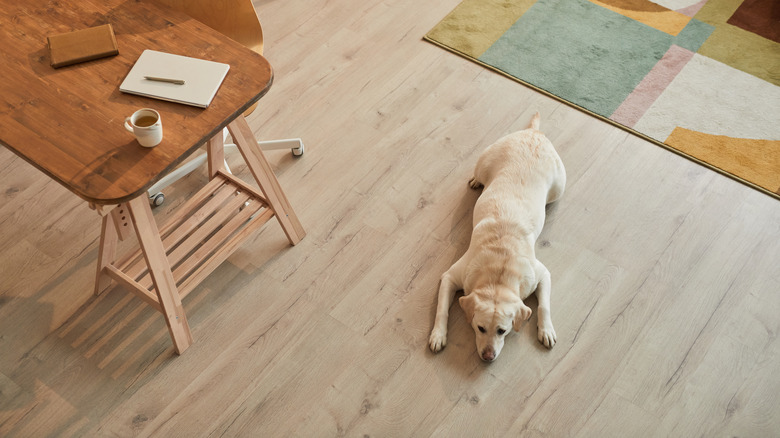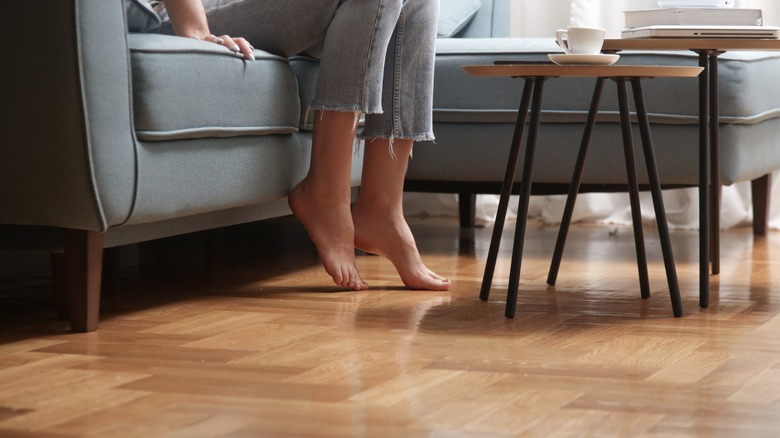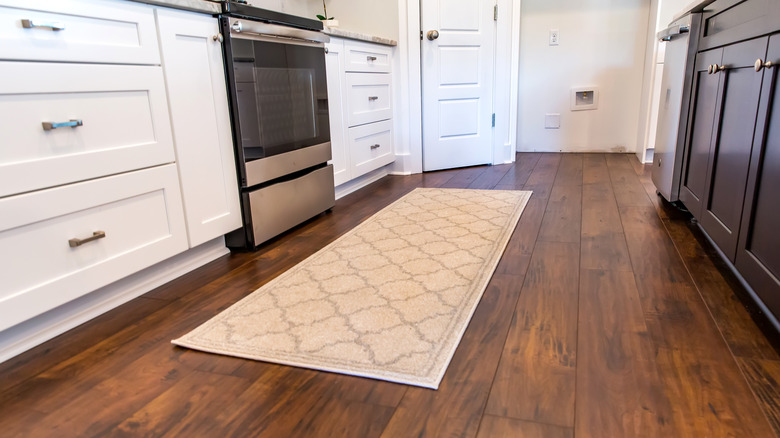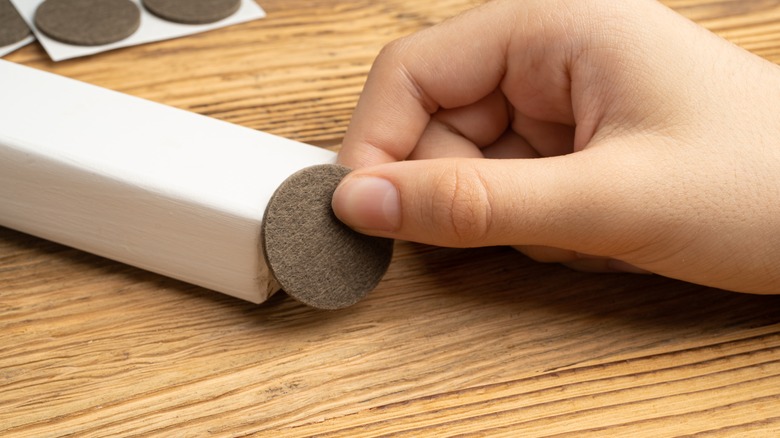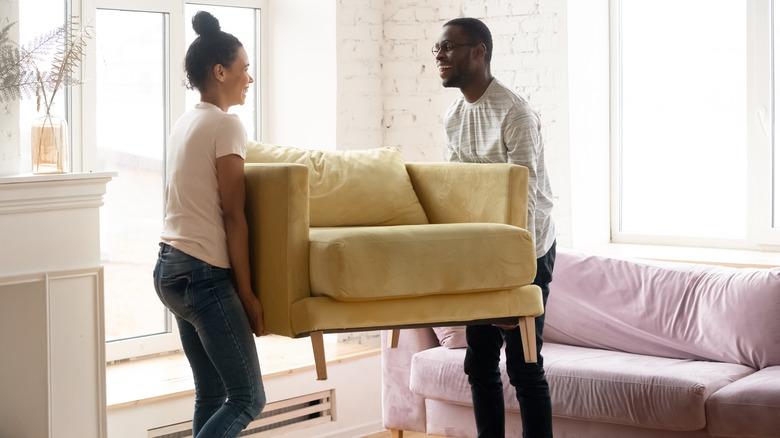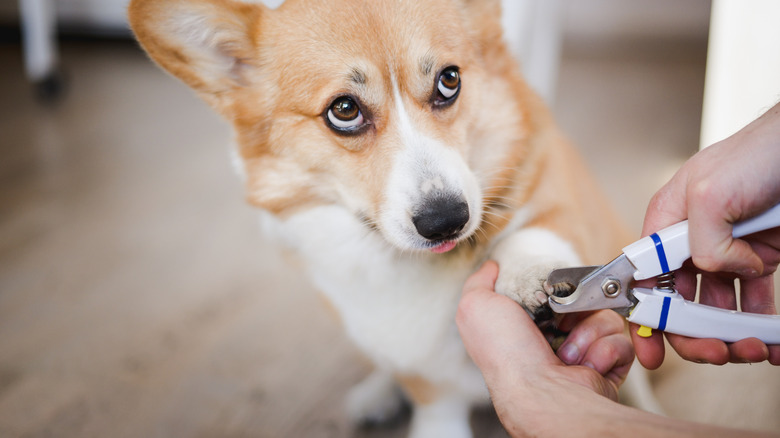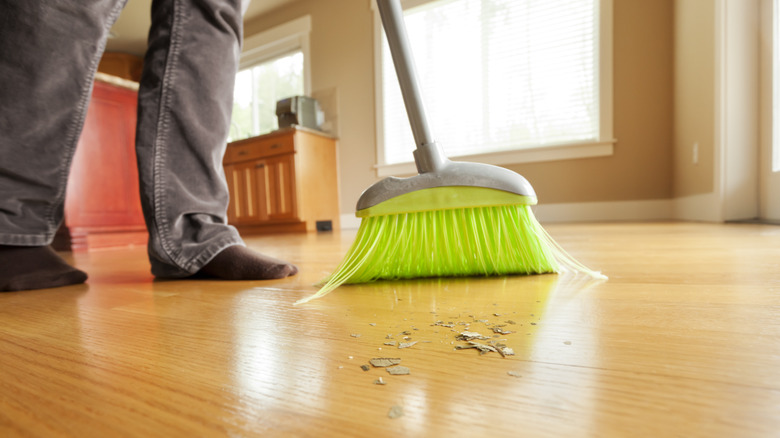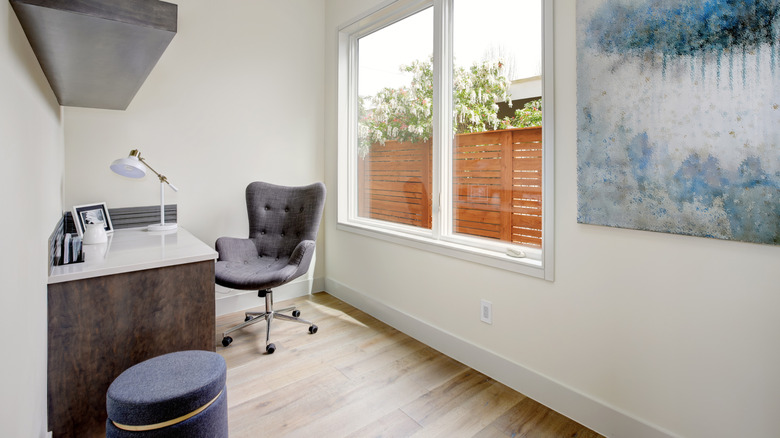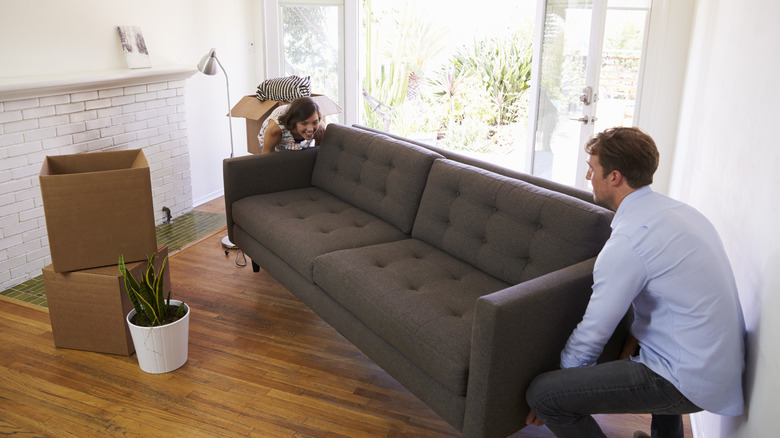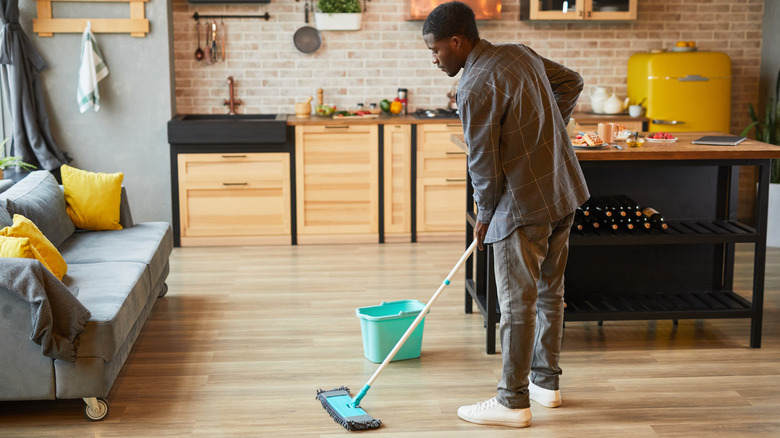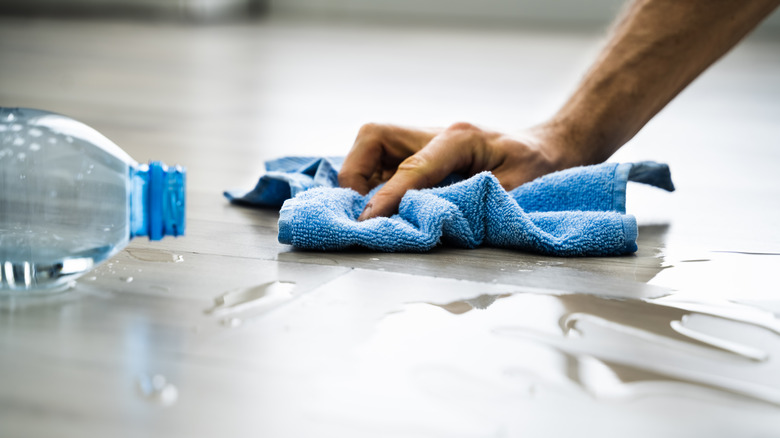Tips And Tricks To Protect Hardwood Floors From Scuffs And Scratches
To keep your hardwood floors looking great, it's essential to choose the proper sealant and establish a regular cleaning routine. But the secret isn't just learning how to do regular maintenance. Instead, it's in preventing scratches or scuffs. Damage to your hardwood flooring can be very distracting, and it opens the door for more expensive repairs.
The key to keeping your hardwood flooring looking like new is understanding the unique challenges it brings and implementing preventative measures. For example, while common sense tells you basic cleaning and maintenance are a must, what about actionable tricks you can implement to prevent scuffs and scratches? You need to pick the right furniture pads, use the correct cleaning tools, and know how to take care of spills as soon as they happen.
Refocusing on these preventative tips and tricks lets you keep your flooring looking nice without constantly repairing it. Along with preserving the flooring, these strategies also help you avoid common mistakes that can lead to expensive refurbishments. Protecting your flooring requires daily, small actions that have a huge impact on your floor's longevity and looks. The goal is to maintain your floor's value, and there are several ways to go about it.
Clean your entryway and remove your shoes before walking on the floor
One easy way to prevent scuffs and scratches on your hardwood floors is to keep your entrance area clean and have a no-shoe policy inside. Ensure you sweep your home's entryways and paths. Place doormats at every entrance to catch stray dirt and debris from your shoes. Woodpecker Flooring recommends having both an inside and outside mat at each door, with the outside one being textured to pull larger particles from your shoes.
For the no-shoe policy, have a designated spot by your front door where everyone can put their shoes when they come inside. You can also offer guest shoe covers or indoor slippers if they don't want to run around in their socks. If you have space concerns, adding a decorative shoe organizer can help eliminate cluttered shoe piles.
This protects your floors because sand, dirt, and pebbles often stick to the bottom of your shoes, leaving scratches. The tiny scratches build up, eventually dulling your floor's finish and embedding dirt deep into the wood. Also, walking on hardwood with your shoes, especially if they have hard soles or high heels, can put pressure on the floor and damage the wood. They can create permanent indentations, so you remove these pressure points by having everyone take their shoes off.
Lay rugs in high traffic areas, and pay attention to backing
One way to keep your hardwood floors looking new is to provide a buffer between the flooring and anything that walks, rolls, or sits on it, especially in high-traffic spots. Focus on the living room, hallways, and spaces by your sinks or stove. Pick rugs that fit these areas, and lay them down over the floor without obstructing furniture or doorways.
However, pay attention to the type of backing your rug has. A rug with a natural rubber backing grips the floor to prevent it from sliding. Natural rubber is less likely to leave stains or marks when compared to synthetic rubber, like PVC, because these can break down and stick. The rug should also feature material that traps grit and dirt as people walk on it, which is why thicker, woven rugs (like wool) are popular. Secure your rugs with non-slip pads or double-sided tape along the edges so they don't slide or bunch up.
Without protection, constant foot traffic can grind sand, dirt, and fine particles into the wood, slowly removing the finish. Eventually, deep scratches will occur, which are expensive to fix. The backing choice is also essential because natural rubber won't leave a sticky residue that you have to peel from the floor. Synthetic alternatives may even discolor the floor, leading to expensive repairs.
Put fabric pads on the bottom of furniture pieces
A practical way to save your hardwood flooring is to attach fabric pads to any part of your furniture that sits on your floors, including tables, chairs, and sofas. You can use multiple fabric pads or rubber pads for oversized appliances like stoves or refrigerators. Buy high-quality fabric pads from your local home improvement store and look for ones made out of soft fabric blend, rubber, or felt. Wipe down the furniture bases with a damp cloth to remove dirt or grime, and allow them to dry. You want to cover the whole bottom surface. Also, if the items are extremely heavy or something you move a lot, like dining chairs, keep an eye on these pads to make sure damaged ones get replaced.
Installing these fabric pads is essential to help save your floor's finish and stop scuffs or scratches from appearing. When you use or move it regularly, furniture can gouge or scratch the wood and cause expensive repairs. The minor scratches also take away from the look of your floors and attract grime, making your flooring look dingy. Fabric pads form a soft buffer between the floor and furniture while stopping rough bases or sharp edges from doing damage. Larger pads under heavy items can help distribute an object's weight more evenly. This is especially important if you have an active family or tend to rearrange the furniture because it lowers your risk of gouging or scratching anything.
Rearrange furniture to prevent uneven aging, fading, or scratches
To stop your hardwood from getting worn or aging unevenly, rearrange your furniture occasionally. Doing so will refresh your room's look and remove the constant pressure on the same spot to maintain even coloring across your whole floor. Plan a layout that shifts the heavier pieces to different areas in the room. You could swap your chair and sofa position, move a bookshelf across the room, or rotate your dining room table. Remember to lift the furniture instead of dragging it. If you can't lift it, use furniture slides to glide the pieces over the hardwood. Additionally, move your rugs or floor coverings to evenly expose all areas to light and prevent discoloration. If you move your furniture, move the floor covering at the same time.
Fixed furniture layouts can cause uneven wear patterns, scratches, or indents that stick out much more in exposed areas where there is a lot of foot traffic. By changing your room's layout, you help the whole floor wear more evenly. Any areas you hide under rugs or floor coverings have a hard time getting sun exposure, so parts of your floor will look darker if you don't swap them. You also get a chance to clean under your furniture or floor coverings as you move them to remove debris that could scratch the finish.
Trim your pet's nails
The easiest way to keep your home pet-friendly and protect your flooring is to trim your pet's nails. If their nails are too long, they can scratch and gouge the floor as they walk around. There are several different types of nail trimming tools designed for pets, including clippers, scissors, and grinding tools. Once you have chosen the tool that is right for your pet, consult with your veterinarian to learn how to trim their nails safely. Plan on trimming their nails before they reach the floor; The amount of time between trimmings varies between pets.
Trimming their nails is critical to keeping your pet happy and healthy and your floors scratch and gouge-free. Long nails can scratch the floor as your pet moves around, and dirt can build up in these spots. If the scratches are deep, they may require DIY or professional repair. Also, shorter nails are less likely to get caught on carpets or in cracks, which can lead to injuries.
Sweep the floor regularly
One of the easiest ways to clean hardwood floors is to sweep them daily using a soft-bristle broom, typically featuring synthetic fibers or natural materials that are gentle enough to clean without impacting the finish, especially on old hardwood floors. The broom type you pick is vital because stiff bristles can scratch the floor's finish. Starting at one end of the room, sweep gently toward the other to collect the grime, dirt, and dust. Use soft, short strokes to collect all the stray particles without causing damage. Gather the dirt into a neat pile, and use a dustpan to collect it. If you have spots that you can't reach with a broom, like spaces between your furniture or into corners, you can use a microfiber cloth. This cloth will pick up and trap dust particles instead of pushing them around, reducing the chances of scratching anything.
Sweeping the floors regularly is vital for stopping dirt and grit from building up because this can damage the finish. These particles gradually wear away at the finish, leaving deeper gouges and scratches. By removing the particles, you're protecting your flooring's look. Maintaining your floors also boosts your home's appearance, and this impacts the market value because potential buyers will look at your floors and use their condition as an indication of your home's overall upkeep.
Avoid chairs with rollers
Avoid using chairs with casters or rollers on your hardwood floors. You typically find these chairs in offices, and they can cause cumulative damage from scratches caused by rollers. If you already own one, see if you can swap out the wheels with the rubberized, soft ones designed to be hardwood-friendly. Protective chair mats are not suitable for hardwood floors, as they can trap dirt and grind it into the wood. Only use a chair mat on plush carpet.
Clean your chair wheels regularly to remove grime that can scratch the finish. Dirt and grit can easily get lodged in the wheels and leave deep scratches or gouges as you move around the floor. By cleaning them, you're reducing the risk of dragging abrasive things around. If you don't take any of these steps, your roller chair can cause scuffs, indents, and scratches that look bad and can be a nuisance to fix.
Lift heavy objects instead of sliding them
Changing how you lift things and using tools like a pry bar to do the heavy lifting for you can save your flooring. Lift furniture instead of sliding to prevent scratching or gouging the floor. Stand close to whatever you want to move, squat down, and grab the base instead of bending at your waist. Lift using your legs, keeping your back straight to reduce the strain on your body and give you more control. For extremely heavy items, recruit help to share the load and maneuver the piece so you don't drop it. Furniture sliders are other options if you have pieces that are too big to move alone or a long way. Put a slider under each leg or corner to distribute the weight and glide it over the floor.
Sliding furniture or heavy things across your floor grinds debris and dirt, gouging or scratching the surface. These damages make the floor look dingy as they collect dirt and may require time-consuming or expensive refinishing.
Use appropriate cleaning products to prevent damaging the finish
Use cleaning products or natural remedies that won't damage the finish to keep your hardwood floors in good shape. You can get a cleaner specifically designed for hardwood or use black tea to clean hardwood floors. Avoid all-purpose cleaners and those with harsh chemicals like bleach or ammonia because they can strip the finish and make the floor look dull. Try not to use oil soaps because they can leave a slippery residue if you're not very thorough when you wipe it clean.
Test cleaning products on a small area of your flooring to ensure they don't discolor the surface before going over the whole area. Use a soft, damp microfiber mop to apply your cleaner, and monitor how wet it is because too much water can seep into the floor's cracks and seams, making the boards warp or swell. Work with the woodgrain to remove any stuck dirt, focusing on any sticky residue or tough scuffs. You can also bring a soft-bristled brush and gently scrub to lift the dirt.
Using the correct cleaner is essential for keeping your floors looking as nice as possible and helping them last. The wrong cleaners can damage the finish, leading to repairs. Harsh chemical exposure can corrode the finish, and too much water can cause swelling or rot. This damage weakens your flooring structurally and makes it look bad.
Clean up spills right away
As soon as a spill happens on your floor, clean it up to help prevent the liquid from seeping into the seams, spreading, and causing discoloration, warping, or swelling. Use a soft, absorbent cloth or paper towel to blot at the liquid gently. Once you finish blotting up the original spill, get a damp cloth and wipe the area to remove any residual film or stickiness. The fabric shouldn't be soaking wet because introducing too much water to the floor can also lead to moisture damage. If the spill is oily or has a color, like juice or wine, you may need a specific hardwood floor cleaner to remove any stains. Apply it sparingly and wipe the area before drying it with a new cloth.
Immediately cleaning spills is critical to stopping long-term damage. Wood is naturally porous, which means that it quickly absorbs liquid. Moisture can also mark and stain wood finish, leaving nasty water marks.
